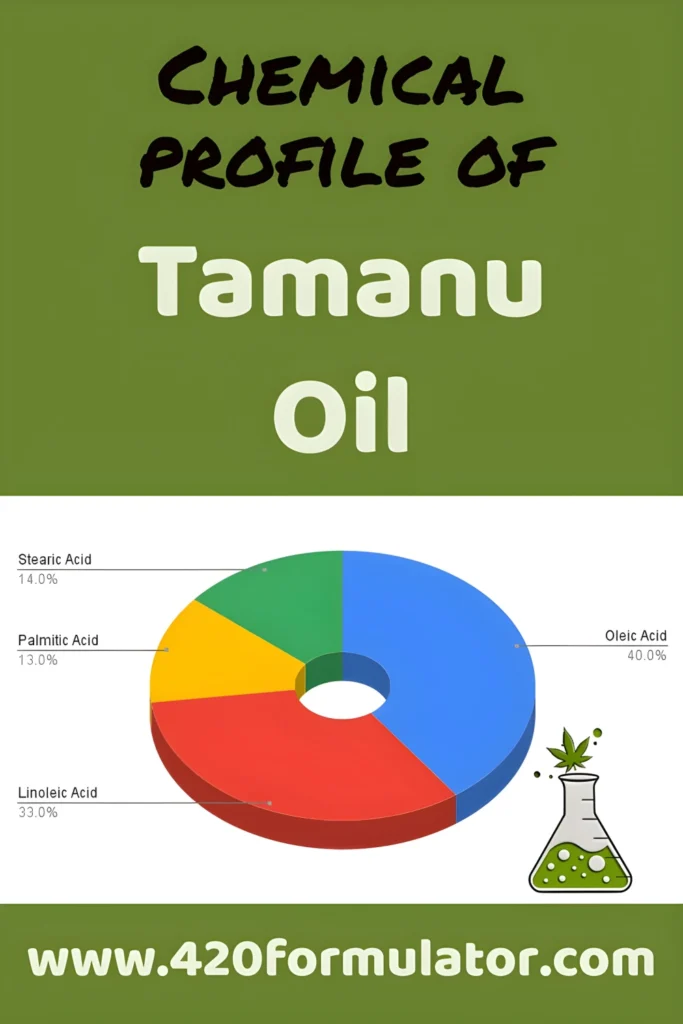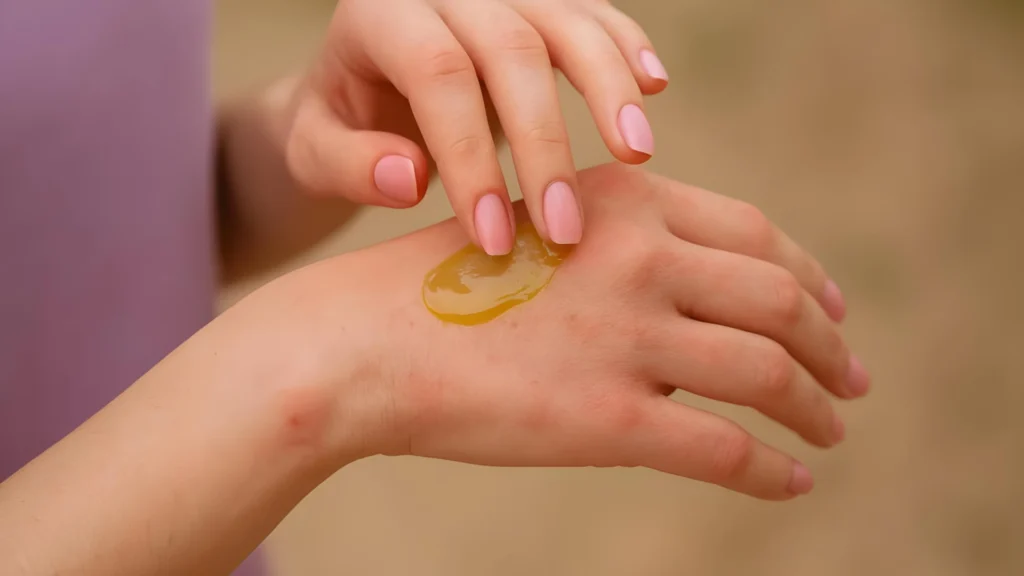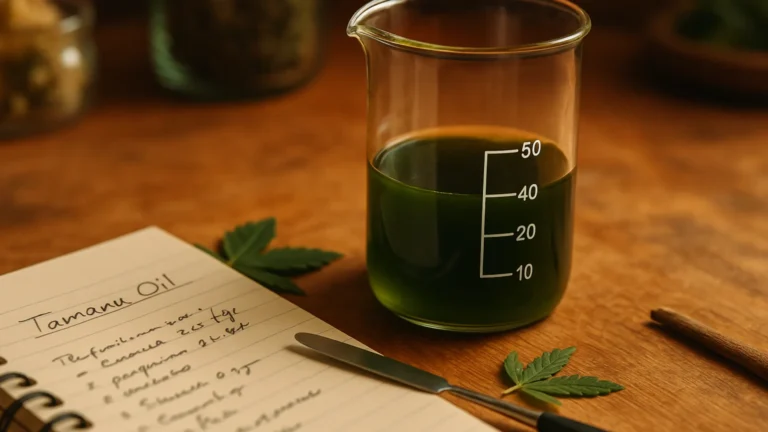Tamanu oil is a thick, green oil traditionally used for wounds, inflammation, and skin repair. In natural skincare, it’s known for its ability to support healing in scarred, eczema-prone, and irritated skin. It also works well in cannabis-infused formulas and massage blends, where both its physical and energetic properties come into play.
Table of Contents
*As an Amazon Associate, I earn from qualifying purchases
Botanical Name and INCI
Tamanu oil is made from the shiny nuts of the Calophyllum inophyllum tree. This tree can be found along coastlines in places like Madagascar, Vietnam, and Polynesia. It’s a traditional skin remedy across the South Pacific, used for everything from infected wounds to sunburn and itchy skin. It’s a member of the Calophyllaceae family, and the INCI is Calophyllum Inophyllum Seed Oil.
In modern skincare, it is still relied on for scarring, eczema, and inflamed skin. It’s got an unmistakable scent and feel that tells you it’s really doing something.
Extraction Method
Tamanu oil is cold pressed from the dried kernels of the tamanu nut. After the nuts are harvested, they’re just left out to cure on their own. This lets the oil inside them get thicker and brings out that rich green color and nice earthy smell. Once pressed, the oil is filtered but not refined.
The result is a thick, sticky oil with a rich, nutty, and slightly “hay-like” smell. It has a tacky feel that lingers on the skin without fully absorbing right away. This is why care has to be taken to blend it well with other oils or ingredients to make it feel more elegant on the skin. However, its raw form is very active and highly concentrated.
The colour ranges from greenish yellow to deep brownish green depending on origin and harvest. It lasts about 2 years when stored properly but may thicken in cooler temperatures. Warm it gently to make it pourable again.
Tamanu Oil’s Composition & Key Nutrients

In terms of essential fatty acids, it’s rich in:
- Stearic Acid – around 12% to 20% which gives the oil a protective, occlusive feel that helps lock in moisture and support dry or damaged skin.
- Palmitic Acid – comprising about 10% to 15% of the formulation, enhances structure and glide, enriching the oil while simultaneously supporting the skin barrier function.
- Oleic Acid (Omega-9) – makes up 30% to 55%. It softens and conditions the skin, enhances the absorption of other active ingredients, and provides a rich, nourishing feel.
- Linoleic Acid (Omega-6) – comprising 20% to 40% of the formulation, plays an important role in restoring barrier function, soothing inflammation, and promoting clearer skin in areas affected by acne or eczema.
It also contains small amounts of sterols and polyphenols, giving it further anti-inflammatory and antioxidant potential. This makes it an excellent choice for skin that’s damaged, inflamed, or in need of support during healing. Tamanu oil is commonly selected for active skin recovery due to its therapeutic properties, rather than just as a base or carrier.
Tamanu oil has a unique profile that goes beyond just essential fatty acids. It contains:
- Calophyllic acid – known for antimicrobial and healing properties.
- Lactone compounds – with some anti-inflammatory and antibiotic action.
- Coumarins – which support circulation and tissue regeneration.
Stability for Cannabis Infusion
Tamanu oil is stable up to 52°C (125°F) but should not be heated above 57°C (135°F), as higher temperatures can harm its beneficial compounds. Gentle warming between 46°C (115°F) and 49°C (120°F) is fine if it becomes cloudy.
The POT by NOIDS infuses at 100°C (212°F), which is too hot for Tamanu oil. I don’t recommend using Tamanu as a direct infusion oil. Instead, infuse a more heat-stable carrier like MCT or olive oil, then add tamanu afterwards to preserve its skin-repairing properties.
Skin Care Benefits
Tamanu oil is well known for its ability to help skin recover from damage. It promotes new tissue growth, supports elasticity, and calms inflammation without leaving a greasy residue. It’s a favourite for treating chronic skin problems and makes a solid addition to anti-ageing and post-acne products.
Key Skin Benefits:
- Encourages new tissue growth to support faster healing.
- Softens the look of scars and stretch marks.
- Helps reduce the appearance of fine lines and wrinkles.
- Useful for rosacea-prone skin when blended with calming oils like Rosehip.
- Calms eczema symptoms and relieves itchiness in red, cracked, or flaking skin. It’s an absolute powerhouse when combined with Calendula herb for eczema.
- Antibacterial and anti-inflammatory, making it effective for acne-prone skin.
- Regulates oil production without drying or stripping the skin.
- Offers mild daily UV protection as part of a barrier cream.
- Moisturises dry, flaky areas like knees and elbows.
- Reduces ingrown hairs and razor irritation in men’s aftershave products.
- Helps calm and soothe nappy rash in baby care balms and creams.
- Works well in massage blends for nerve pain and joint stiffness.
Tamanu oil sinks in slowly and keeps working over time, making it ideal for overnight use or in leave-on products. Blend it with Shea Butter, Calendula, Rosehip or Sea Buckthorn when you want a strong skin recovery base. Pairs well with Pomegranate Seed oil in mature or weathered skin blends.

Hair and Scalp Benefits of Tamanu Oil
Tamanu oil is great for more than just your skin! Its anti inflammatory and antimicrobial actions can be a big help when dealing with dry scalp, itching or flakiness. It supports healthier hair growth by calming irritation and encouraging better skin function at the root.
Key Hair Benefits:
- Soothes irritated or inflamed scalp conditions.
- Reduces flaking and dry scalp.
- Helps relieve itchiness and calm redness.
- Can support hair growth by improving scalp health.
- Adds softness and shine without heavy residue.
- Useful in dandruff blends and leave-in scalp oils.
Tamanu oil can be used as a spot treatment for problem areas or added at 5% to 10% in scalp serums and conditioning masks. It blends well with camellia, blackseed and jojoba oils for balancing scalp formulas.
Other Uses
Tamanu oil has a few lesser-known uses that don’t fall neatly under skincare or haircare. It’s been used traditionally for joint discomfort, nerve-related pain, and grounding massage blends, especially in folk or energetic practices. It can also help enhance the staying power of essential oils in natural perfumery.
- Used in massage blends to help ease neuralgia, rheumatism and general muscular pain.
- Often included in grounding or calming massage oils and emotional care products.
- Useful in natural perfumery to anchor lighter essential oils and extend wear time>
- Traditionally applied to joints and pressure points in Ayurvedic and Pacific Island medicine.
- Can be used in soothing foot and leg creams, especially for tired or heavy legs.
These uses draw on both its physical properties and its deeper, warming character which is something formulators value when blending for relaxation, pain relief or long body treatments.
Topical Use and Formulation Tips
Tamanu oil can be used at 5% to 100%, though most formulations stick to 10% to 25% due to its thickness and strong scent. It works best in leave-on products where its healing actions can stay active over time.
- Usage rate: 5% to 25% in blends, up to 100% for spot use.
- Shelf life: Up to 2 years if stored in a cool, dark place.
- Comedogenic level: Around 2, suitable for most skin types but patch test if acne-prone.
- Suitable for: Balms, serums, massage oils, eczema blends, baby care, barrier creams.
- Infusion advice: Avoid high-heat infusion, and use in teh Stage 3 (cool down) stage when making creams and lotions.
Blend with lighter oils like Rosehip, Camelina, or Camellia to improve skin feel. Pair with Beeswax or butters like Shea for rich healing balms. Tamanu oil can also be used to boost the performance of cannabis topicals without needing to be the main carrier.
Prefer audio for a repairing hand cream and balm combo? Listen to the Calendula Hand Cream recipe here.
Safety and Storage
Tamanu oil is generally well tolerated on the skin and safe for use in most topical formulations. However, it’s best to follow a few key guidelines:
- Shelf life: Up to 2 years when stored cool and dark, preferably below 20°C (68°F).
- Oxidation risk: Low to moderate – store in amber glass and avoid exposure to heat and light.
- Pregnancy and baby safety: Safe for topical use, including in nappy creams and pregnancy belly balms.
- Nut allergy warning: Tamanu comes from a tree nut, so patch test if there’s a known nut allergy.
- UV use: While it has some natural UV-absorbing properties, it should not replace sunscreen.
Keep the oil capped tightly and store it away from sunlight or radiators to extend its shelf life. If it thickens or goes cloudy, just warm gently in a water bath before use.
Chakra Associations
Tamanu oil is often used in grounding and restorative bodywork. Its warming and nourishing character fits well with TCM Earth-type formulations, helping to stabilise and rebuild weakened or inflamed tissue.
In energy-based systems, it may be associated with the Root Chakra due to its connection to physical healing, support and protection.
- 1st Chakra (Root Chakra / Muladhara)
This chakra connects with our stability, roots, and foundations, and gives us the security of feeling grounded. Frankincense is sometimes used for grounding, helping to release fear and promote a sense of stability.
Location: Base of the spine
Qualities: Grounding, stability, safety
Mantra: “I am safe, grounded, and supported in all I do”
Colour: Red
Element: Earth
Stone: Red Jasper
Conclusion
Tamanu oil is one of the most effective oils for skin recovery and chronic inflammation. Whether you’re working with scars, eczema, acne, or irritated scalp, it brings active benefits you can feel. It’s thick, sticky, and has a strong scent, which can be challenging to work with, but its proven skin benefits make it worth including in serious skin recovery blends.
In cannabis skincare, it’s best used as a supportive active rather than a primary carrier, especially in formulas aimed at deep repair and calming. It’s especially valuable in formulations that need something active and reliable, whether it’s for barrier repair, flare-up care, or deeper skin recovery. Blend it with complementary oils when you want lasting, therapeutic results.
🎧 Listen Instead
Prefer listening? Play it here or catch it on your favourite platform:
FAQ
What is tamanu oil best used for?
Tamanu oil is best used for skin recovery, especially for scarring, eczema, acne, and inflammation. It promotes tissue repair and calms irritation.
Can you use tamanu oil on your face?
Yes, tamanu oil can be used on the face. It suits acne-prone, reactive, or ageing skin. Use a small amount or blend it with lighter oils.
Is tamanu oil good for acne scars?
Yes, tamanu oil helps fade acne scars by supporting cell turnover and reducing inflammation. It also helps prevent further breakouts.
Can tamanu oil be infused with cannabis?
Tamanu oil should not be used for high-heat infusion. It breaks down above 57°C (135°F). Infuse a stable oil first, then add tamanu after.
Does tamanu oil clog pores?
Tamanu oil has a comedogenic rating of about 2. It’s usually fine for most skin types, but patch test first if you’re acne-prone.
Can tamanu oil be used on babies?
Yes, it’s gentle enough for baby skin and is often used in nappy rash creams to soothe and protect irritated areas.
What does tamanu oil smell like?
Tamanu oil has a strong, earthy, nutty scent with smoky or hay-like notes. The smell fades when blended, but may linger slightly.

If you liked this blog post, I would love it if you shared it with a friend.
If you use Pinterest, please pin this post.


 Spotify
Spotify


